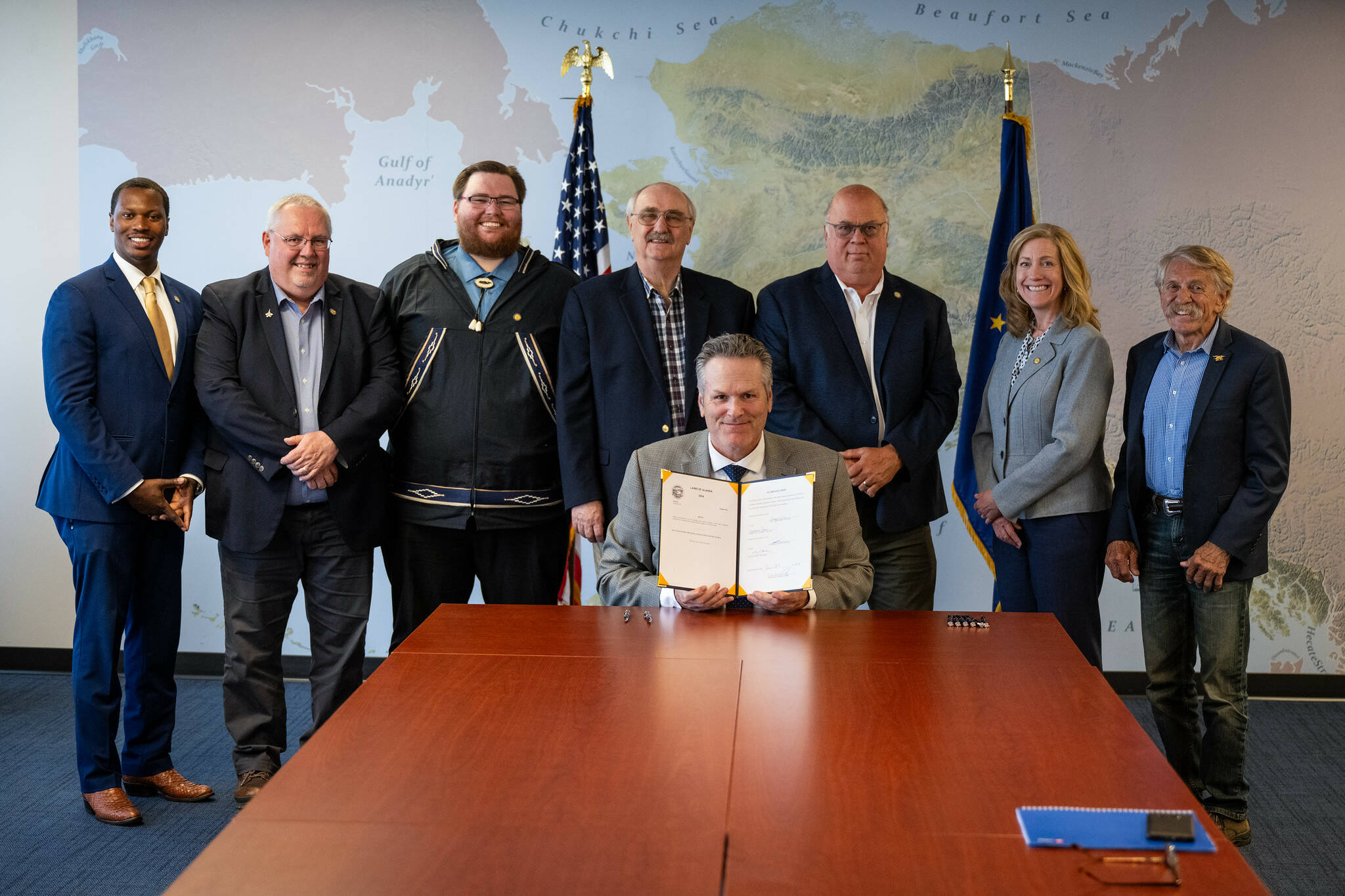A state capital budget signed by Gov. Mike Dunleavy at the same time as the state operating budget on June 27 describes around $3.7 million in state money directed at Kenai Peninsula capital projects. An additional $3.3 million in capital funding to the Kenai Peninsula was vetoed by the governor.
The capital budget documents describe nearly two dozen peninsula projects set to benefit from capital funding either as part of the budget for the current fiscal year — which began July 1 — or as supplemental spending for the last fiscal year. In addition to the state money, around $90 million in federal funding is coming to the Kenai Peninsula.
Kenai Peninsula projects include around $65 million for the Sterling Highway Safety Corridor Improvements Project; $18 million for reconstruction of the railroad crossing at Milepost 14 of the Seward Highway — between Moose Pass and Seward; nearly $3 million for drainage improvements on Kalifornsky Beach Road; and $2 million for creation of a pedestrian pathway on Kenai’s Bridge Access Road.
Other funded projects for the current year include the purchase of material for Seldovia’s Safe Roads Project; remodel and expansion of the kitchen at the Ninilchik Senior Citizens Center; reconstruction of Kachemak Bay Drive between its intersections with the Sterling Highway and East End Road; creation of the Homer All-Ages and Abilities Pedestrian Pathway; installation of a flashing light at the intersection of Kalifornsky Beach Road and the Sterling Highway in Kasilof; wintertime sand for Soldotna street maintenance; rehabilitation of a space of road in Soldotna where Redoubt Avenue and Smith Way connect near the Y; repaving the Bear Creek Fire Station’s parking lot; improvements to the intersection of the Seward and Sterling Highways; and flood mitigation in the Seward-Bear Creek Flood Service Area.
Projects included in supplemental funding for last year include replacement of a failed roof at the Alaska SeaLife Center; replacement of a water transmission line in Seldovia; money to support an expanded scope of investigation for the Homer Harbor Expansion; purchase of a new refrigerator for the Kenai Peninsula Food Bank’s Fireweed Diner; maintenance and repair of the Cooper Landing Emergency Services facility; conversion of the Funny River Community Center to an emergency center; and replacement of equipment at Moose Pass Volunteer Fire Company.
All of those projects are described in budget documents as specific to the Kenai Peninsula, though a pair of larger “statewide” projects will certainly impact the peninsula as well.
Nearly $93 million in federal funding is earmarked for the replacement of the MV Tustumena. State information about that project says that the Tustumena is one of two ocean-class vessels in the Alaska Marine Highway System, the only vessel in the fleet “capable of serving all 13 ports of call between Homer and Unalaska.” The replacement vessel would be larger, with accommodations for 250 overnight passengers. It would also have modernized safety features and “increased seaworthiness.”
Around $1.4 million in funding initially targeted in 2006 for the Alaska-British Columbia Intertie — a project last considered by the Alaska Legislature in 2010 — is redirected to the Dixon Diversion Project, which would expand the Bradley Lake Hydroelectric Project near Homer. A proposal document submitted to the state says the project “could electrify an additional 24,000-30,000 homes on the Railbelt,” helping mitigate the projected shortfall of Cook Inlet gas supply and demand.
Sen. Jesse Bjorkman, R-Nikiski, in June called Bradley Lake “the cheapest electricity on the railbelt.” He said that the Dixon Diversion, when completed, would greatly increase the dam’s output and put downward pressure on electricity rates.
Kenai Peninsula projects that the governor vetoed include a variety of improvements for the Kenai Senior Center, Nikiski Senior Center, Sterling Senior Center, Sterling Community Center and Funny River Community Center. Dunleavy also chopped a roof replacement for the Homer Society of Natural History.
A total of $700,000 set to go to the Kenai Peninsula Borough for improvement of “substandard roads” was vetoed, as was money for improvements to the borough’s Solid Waste Department Transfer Site.
Soldotna saw $690,000 for design of an expansion to the Soldotna Regional Sports Complex’s conference rooms vetoed.
Kenai saw cuts to money for its wastewater treatment plant lift stations, street lighting improvements and purchase of two trucks for the water and sewer department.
In every instance, Dunleavy wrote that the vetoes were to “preserve general funds for savings and fiscal stability.”
Speaking to the Kenai City Council on July 3, Rep. Justin Ruffridge, R-Soldotna, lamented the number of vetoes borne by the Kenai Peninsula. Other areas of the state, he said, saw “tens of millions of dollars in capital.”
Kenai Peninsula Borough Mayor Peter Micciche similarly chafed at the vetoes during a borough assembly meeting Tuesday. He pointed to the $700,000 cut for road improvements as “inexplicable.” That money would have done much to address long-standing issues on borough roads.
“There may be some personal things,” he said. “None of it should have anything to do with the 60,000 residents, the people of the Kenai Peninsula, nor the half million people that visit us every year — their safety.”
Full breakdowns of veto amounts and projects funded by district can be found at omb.alaska.gov.
Reach reporter Jake Dye at jacob.dye@peninsulaclarion.com.

